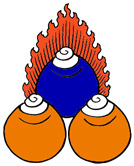| |

Studies
in
Buddhadharma
On Arathood or (my) Liberation
 Contents
Contents  SiteMap
SiteMap

"As a lotus, fair and lovely,
By the water is not soiled,
By the world am I not soiled,
Therefore, Brahmin, am I Buddha."
Ekottarâgama (Anguttara-nikâya),
II.6.
|
The "Arhat" ("worthy one") or Foe
Destroyer attained the highest level in the Lesser Vehicle. All defilements ("âsrava") and passions
("kleśa") have been extinguished and will not arise again. Ignorant
craving and hatred are completely gone, while nearly all ignorance
has been annihilated. During life, Arhathood is conditioned
"nirvâna" ("sopadhiśeśa-nirvâna"),
attaining full extinction immediately following this life. The main
emphasis of the Arhat is to gain his own salvation. He is free of the ten
fetters.
Liberation or enlightenment (in the Lower Vehicle, these two are not distinguished), involves the breaking of a succession of "fetters" ("samyojana"),
ten in number :
(1) separate selfhood, (2) sceptical doubt, (3) attachment
to rules and rituals for their own sake, (4) sexual desire, (5) ill will,
(6) desire for existence in the world of form, (7) desire for existence in
the formless world, (8) conceit, (9) restlessness, (10) ignorance.
Four stages mark the supramundane path leading to Arhathood
("lokottaramârga") :
-
the
"stream-enterer" ("śrotâpanna")
: has eradicated the first three fetters. He
has only seven rebirths in the human or god realms before liberation ;
-
the "once-returner"
("sakridâgamin") : reborn once more, has weakened the fourth &
fifth fetter ;
-
the "non-returner"
("anâgamin") : has broken all the first five fetters and
is reborn in the god realm from where liberation is attained ;
-
the Arhat or "Worthy One"
: has broken all ten fetters and has won liberation in
this life.
Together, these four stages define
the "Ârya-Sangha", the Sangha Jewel of Early Buddhism,
emphasizing the individual practitioner.
|
In the Mahâyâna, stressing
Bodhicitta,
Arhathood (liberation) became a lesser goal than the one realized by the
Bodhisattva :
Buddhahood. The
Lesser Vehicle
only leads to liberation, a "personal" kind of "nirvâna" characterized by
the end of samsaric suffering, but not to awakening, the full
enlightenment intended by the Buddha. This implies the Arhat has in fact
not eliminated all obscurations, but only those pertaining
to afflictive emotions & the emptiness of self. While the foes of desire, hatred
and ignorance have been destroyed, achieving liberation from cyclic
existence, he has not annihilated both the ignorance assenting to the
false appearance of inherent existence, nor the false appearance itself.
Indeed, in the Lower Vehicle tenet systems, "own-form" ("sva-bhâva") is
maintained.
Because the larger perspective, including others and their
dependent-arsing, is lacking, omniscience is not attained. Arhathood is a
stage, not a station.
In the Lesser Vehicle, Buddhahood is identified with the complete
destruction of all afflictive emotions. This is done by attaining a
special knowledge of all phenomena. In this view, a Buddha is all-knowing in the sense
of being able to know anything he wishes by merely turning his mind to it,
but not in the Greater Vehicle sense of realizing everything
simultaneously (as the Âdi-Buddha does). For the Greater Vehicle, the Arhat still has a
non-afflicted type of (innate) ignorance as obstructions preventing omniscience,
the simultaneous knowledge of all things, directly realizing phenomena and
their emptiness at the same time.
The Arhat achieves wisdom without the practice of the perfections, but
only through limitless analysis. So he only overcomes the obstructions to
liberation, freedom from cyclic existence. While there is not a difference
in the type of wisdom between the Lesser & Greater Vehicles, there is a
difference in the mode of cultivation and so in the eventual
effect. By engaging in the practices of the
Great
Perfection Vehicle, the Mahâyâna Bodhisattva approaches Buddhahood. To
achieve it, he has to perfect wisdom by eliminating innate self-grasping.
The Foe Destroyers cannot approach Buddhahood, but only realize freedom
from the suffering of "samsâra".
They no longer suffer, but lack the capacity to aid others.
While the Foe Destroyer has eliminated all afflictive emotions,
self-cherishing and acquired (intellectual) self-grasping and so is liberated from
the sorrows of cyclic existence, he has not annihilated all innate
self-grasping, making his mind still posit inherent existence. Realizing
the
identitylessness of persons, he has not approached the identitylessness of
phenomena.
In terms of the Bodhisattva training (the Ten Stages), the Arhat has not
completed the last three Bodhisattva stages, but dwells in the Sixth Stage.
The difference between Arhathood and Buddhahood is defined
by subtle innate cognitive obstructions. To eliminate these, in particular
substantial instantiation, the Bodhisattva is backed by his Vow, as well
as by Tantra and the
Great
Perfection. Lacking this, the Arhat cannot eliminate very subtle
innate self-grasping and is therefore "stuck" in his own, little private
"nirvâna" ... Arhathood too has to be overcome.

|
|



